Hi all,
I'm back for more help, if you please. =)
We started burning our new Jotul f400 Castine stove about a week ago. Week 1 of heating with wood. 2 days into it I realized our wood wasn't up to snuff, probably in the 20s % moisture content. I got a moisture meter and that's what some of it was measuring.
So we swapped a load of 2/3 year seasoned ash and etc which is reading about 12 to 15% moisture and have been burning that the past 4 or 5 days. This is on the inside face of a fresh split at room temperature.
I went up on the roof today to check the chimney and see the following: yellow discoloration on the outside of the pipe, brown glue-like substance around the rain cap fitting, and a shiny black coating inside the rain cap and flue.
Evidently something is extremely wrong but I don't know what. We have 14' of flue from top of the stove and have been hitting 400+ degrees on every burn, up to 500 and 600 fairly often. The glass is keeping itself clean. The stove pipe is Selkirk double wall going into Selkirk Supervent double wall stainless, all straight vertical.
I turn the air to 75, 50, then 25 in increments. Ive done it too fast a few times and smoldered a few, but just right some other times and gotten a nice extended burn with secondaries.
Apart from a few rookie mistakes since we are learning, I'm not sure how we could have caused this so quickly.
A couple of thoughts, with cons:
1) Maybe I should add another 3' of chimney? It will look ridiculous and I already have 1 support bracket on the 7' above the house (small single story ranch)
2) maybe I shouldn't run a fan across the top of the stove? If it's cooling the stove pipe could that cause buildup?
3) Maybe burn a creosote removal log every couple of days? That may hurt the wallet though.
4) No idea about the stainless discoloration yet..
I'm currently burning it with 2 large splits sitting E/W on top of 2 smaller splits sitting n/s. 500* on top, secondaries glowing, and air at 25%. Outside temp is 45*.
I tried to cover as much as possible in this post to hopefully narrow it down to the right solution quickly. Otherwise not sure if I should be concerned to continue burning.
Thanks so much,
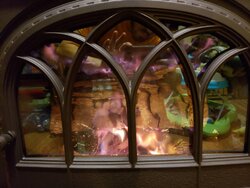
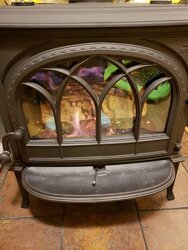
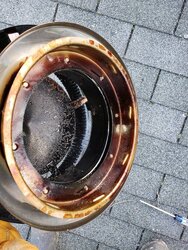
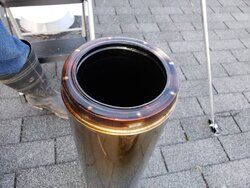
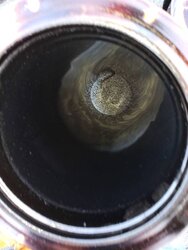
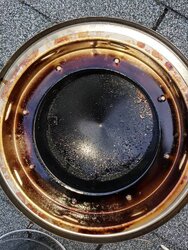
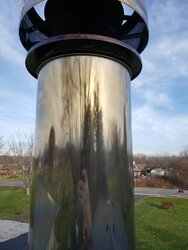
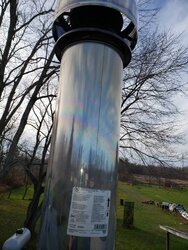
I'm back for more help, if you please. =)
We started burning our new Jotul f400 Castine stove about a week ago. Week 1 of heating with wood. 2 days into it I realized our wood wasn't up to snuff, probably in the 20s % moisture content. I got a moisture meter and that's what some of it was measuring.
So we swapped a load of 2/3 year seasoned ash and etc which is reading about 12 to 15% moisture and have been burning that the past 4 or 5 days. This is on the inside face of a fresh split at room temperature.
I went up on the roof today to check the chimney and see the following: yellow discoloration on the outside of the pipe, brown glue-like substance around the rain cap fitting, and a shiny black coating inside the rain cap and flue.
Evidently something is extremely wrong but I don't know what. We have 14' of flue from top of the stove and have been hitting 400+ degrees on every burn, up to 500 and 600 fairly often. The glass is keeping itself clean. The stove pipe is Selkirk double wall going into Selkirk Supervent double wall stainless, all straight vertical.
I turn the air to 75, 50, then 25 in increments. Ive done it too fast a few times and smoldered a few, but just right some other times and gotten a nice extended burn with secondaries.
Apart from a few rookie mistakes since we are learning, I'm not sure how we could have caused this so quickly.
A couple of thoughts, with cons:
1) Maybe I should add another 3' of chimney? It will look ridiculous and I already have 1 support bracket on the 7' above the house (small single story ranch)
2) maybe I shouldn't run a fan across the top of the stove? If it's cooling the stove pipe could that cause buildup?
3) Maybe burn a creosote removal log every couple of days? That may hurt the wallet though.
4) No idea about the stainless discoloration yet..
I'm currently burning it with 2 large splits sitting E/W on top of 2 smaller splits sitting n/s. 500* on top, secondaries glowing, and air at 25%. Outside temp is 45*.
I tried to cover as much as possible in this post to hopefully narrow it down to the right solution quickly. Otherwise not sure if I should be concerned to continue burning.
Thanks so much,








Last edited by a moderator:

